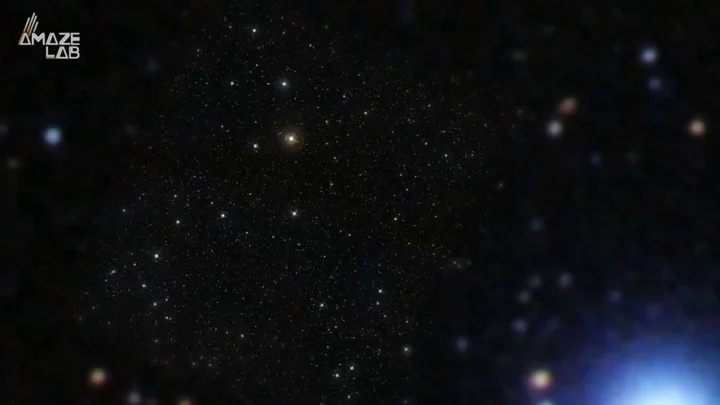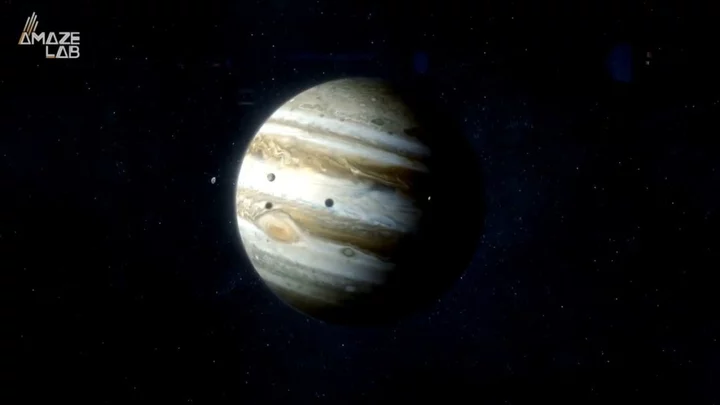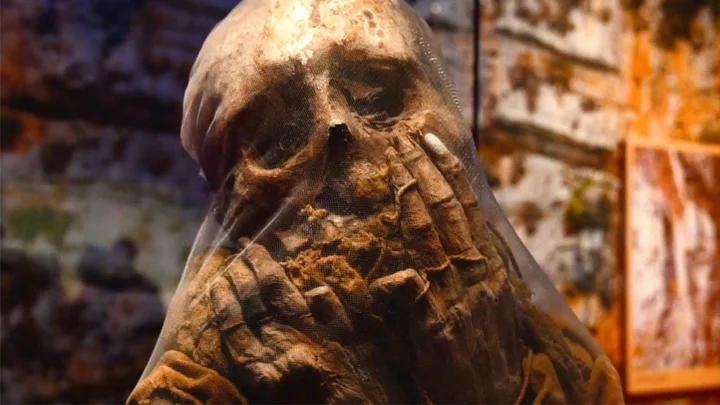
Eerie clip showing just how deep the ocean is has left people with the creeps
A graphic video showing just how deep the ocean really goes is giving people the creeps. Posted on YouTube by MetaBall Studios, the video keeps going down and down in the water, to the likes of the Titanic wreck (which sits at 3700m below the surface), and even the level at which Mount Everest would be completely drowned. However, it has nothing on the Pacific Ocean's Challenger Deep (the deepest part of the ocean), which is around 11,000m down. Scary stuff. Click here to sign up for our newsletters
2023-06-05 18:23

Strange structures pointing towards black hole discovered in space
There’s been another unexpected discovery in our galaxy, after scientists observed strange structures pointing towards a black hole. These “dashes” were spotted in the Milky Way and all aim towards the black hole at its centre. The sheer number of these structures is unprecedented, too, with hundreds of them measuring five to 10 light-years long discovered as part of the new research. The true nature of the dashes remains a mystery, and there’s currently no explanation as to how they got there in the first place. Sign up to our free Indy100 weekly newsletter “It was a surprise to suddenly find a new population of structures that seem to be pointing in the direction of the black hole,” Northwestern University’s Farhad Yusef-Zadeh, who led the research. “I was actually stunned when I saw these. We had to do a lot of work to establish that we weren’t fooling ourselves. And we found that these filaments are not random but appear to be tied to the outflow of our black hole. “By studying them, we could learn more about the black hole’s spin and accretion disk orientation. It is satisfying when one finds order in a middle of a chaotic field of the nucleus of our galaxy.” The research, published in The Astrophysical Journal Letters, also reflects on findings from Professor Yusef-Zadeh in the early 80s, who discovered one-dimensional filaments near the black hole in the middle of the Milky Way, named Sagittarius A*. The new structures are spread out in a different direction, and change the way scientists have been thinking about filaments like this completely. “We have always been thinking about vertical filaments and their origin,” he said. “I’m used to them being vertical. I never considered there might be others along the plane.” Have your say in our news democracy. Click the upvote icon at the top of the page to help raise this article through the indy100 rankings.
2023-06-03 18:16

Scientists discover that the universe is evaporating right in front of our eyes
Every now and then a story comes along which completely changes the way you think about space. For instance, did you know the universe is essentially evaporating right before our eyes? A new study has been released which focuses on the effect that radiation emitted from objects in the solar system can have a massive impact on quantum fields surrounding them. It follows on from Stephen Hawking’s theory that black holes lose mass and evaporate over time as an unusual form of radiation takes effect. Now, astrophysicists Michael Wondrak, Walter van Suijlekom, and Heino Falcke of Radboud University in the Netherlands have stated that this unusual form of radiation is apparent in other objects as well as black holes. Sign up to our free Indy100 weekly newsletter In fact, they believe that “Hawking radiation” could be found in objects apparent everywhere in the universe – and it could mean that the universe is slowly evaporating before our very eyes. "We demonstrate that," Wondrak says in the study published in Physical Review Letters. "In addition to the well-known Hawking radiation, there is also a new form of radiation." "We show that far beyond a black hole the curvature of space-time plays a big role in creating radiation," van Suijlekom explains. "The particles are already separated there by the tidal forces of the gravitational field." Essentially, huge objects in the solar system can cause space-time to bend around them. When that happens, it causes enough change in quantum fields to generate particles which have similar properties to Hawking radiation. Falcke said: "That means that objects without an event horizon, such as the remnants of dead stars and other large objects in the universe, also have this sort of radiation. "And, after a very long period, that would lead to everything in the universe eventually evaporating, just like black holes. This changes not only our understanding of Hawking radiation but also our view of the universe and its future." Have your say in our news democracy. Click the upvote icon at the top of the page to help raise this article through the indy100 rankings.
2023-06-02 19:21

Scientists baffled by discovery of '2000-year-old computer'
Scientists have been left baffled by the discovery of the wreck of a 2,000-year-old “computer” that is amazingly complex. The Antikythera mechanism – an astronomical calendar – has been dubbed “‘the first computer” and has baffled scientists for generations after it was first discovered inside a Greek shipwreck in 1901. The device is a hand-powered time-keeping instrument that used a wing-up system to track the sun, moon and planets’ celestial time. It also worked as a calendar, tracking the phases of the Moon and the timing of eclipses. Despite sounding relatively simple, the mechanism was actually ahead of its time, being more technically sophisticated than any other tool that was invented over the next 1,000 years. In its current condition, the mechanism is in 82 separate fragments with only a third of its original structure remaining, including 30 corroded bronze gearwheels. Sign up to our free Indy100 weekly newsletter Research into the device from experts at University College London involved 3D computer modelling and helped them solve the mystery of how the device worked, revealing a “creation of genius”. Adam Wojcik, a materials scientist at UCL said at the time: “We believe that our reconstruction fits all the evidence that scientists have gleaned from the extant remains to date.” They theorised that the device tracked the movement of the sun, moon and planets on concentric rings, as the ancient Greeks believed that the sun and planets revolved around Earth, rather than the sun. The researchers explained in Scientific Reports: “Solving this complex 3D puzzle reveals a creation of genius—combining cycles from Babylonian astronomy, mathematics from Plato’s Academy and ancient Greek astronomical theories.” Have your say in our news democracy. Click the upvote icon at the top of the page to help raise this article through the indy100 rankings.
2023-06-02 19:20

Ex-Google officer gives stark warning about how AI will evolve in 'months'
An ex-Google officer has shared a warning of the 'danger' AI could pose within 'months' if it keeps growing at the rate it has. Mo Gawdat appeared on Steven Bartlett's Diary of a CEO, where he warned that AI machines have 'emotions' and are allegedly far more 'sentient' than we initially thought. "If we define being sentient as engaging in life with free will and a sense of awareness... then AI is sentient in every possible way", he said. Click here to sign up for our newsletters
2023-06-01 22:55

Scientists make 'shocking' discovery on Saturn's moon that could reveal signs of life
Dramatic explosions on the surface of one of Saturn's moons have been observed, and it could change the way scientists approach the search for life in the universe. Saturn's ice-covered moon Enceladus has been the subject of attention from astronomers for decades after plumes of water vapor were observed erupting from its surface 20 years ago by the Cassini spacecraft. Now, the biggest plume yet has been spotted by the James Webb Space Telescope and it measures a massive 10,000 kilometers in length. Incredibly, the plume emitting from the geyser on the surface measures 20 times the size of the moon itself, and it indicates that there’s more to Enceladus than previously thought. Sign up to our free Indy100 weekly newsletter Planetary scientist Geronimo Villanueva of NASA's Goddard Space Flight Center said: "When I was looking at the data, at first, I was thinking I had to be wrong, it was just so shocking to map a plume more than 20 times the diameter of the moon. "The plume extends far beyond what we could have imagined." Instead of solid ice, the size of the plume shows us that there’s a liquid ocean under the surface. It’s kept warm enough to avoid freezing due to the movement that results from the gravitational pull of Saturn. As ever, the existence of liquid water suggests that there’s the possibility of life existing there, and it's encouraging news for authors of the study accepted in Nature Astronomy. "The orbit of Enceladus around Saturn is relatively quick, just 33 hours. As it whips around Saturn, the moon and its jets are basically spitting off water, leaving a halo, almost like a donut, in its wake," Villanueva said. "In the Webb observations, not only was the plume huge, but there was just water absolutely everywhere." It remains one of the most interesting bodies being studied in the solar system, as geochemist Christopher Glein of the Southwest Research Institute. “Enceladus is one of the most dynamic objects in the Solar System and is a prime target in humanity's search for life beyond Earth," geochemist Christopher Glein of the Southwest Research Institute said. "In the years since NASA's Cassini spacecraft first looked at Enceladus, we never cease to be amazed by what we find is happening on this extraordinary moon." Have your say in our news democracy. Click the upvote icon at the top of the page to help raise this article through the indy100 rankings.
2023-06-01 22:29

Scientists discover secret 'mega-city' underground while studying ants
Scientists who were attempting to map an abandoned ant hill didn't expect to find a mega-city when they shot the hill full of cement, but that's exactly what they discovered. Over three days, scientists pumped 10 tons of cement into the empty ant hill to map its networks. After the cement dried, they dug for weeks around it. Sign up to our free Indy100 weekly newsletter The excavation revealed an incredibly impressive, intricate, and bizarre ant mega-city. The mega-city was a truly colossal undertaking. A video revealed that the ants created the structure by displacing 40 tons of dirt. And it really is a mega-city. The ants networked to disposal pits and fungus gardens. Each tunnel was designed to ensure thorough ventilation and reduce transport time. The narrator disclosed the truth. That despite the complex nature of the mega-city, there was no single architect of any - but it was down to the collective will of the colony. "Everything looks like it has been designed by an architect a single mind but of course, that isn’t true," they said. "This colossal and complex city was created by the collective will of the ant colony, the super organism." The short resurfaced clip is from a much longer piece called Ants! Nature’s Secret Power. You can watch the full documentary here. Our city designers should take a few notes. Have your say in our news democracy. Click the upvote icon at the top of the page to help raise this article through the indy100 rankings.
2023-06-01 20:16

AI can now show you new angles on your favourite memes
Rarely a day goes by at the moment without another breakthrough in artificial intelligence that seemingly fascinates and horrifies us in equal measure. The newest trend around AI involves the expansion of pre-existing pictures to show what the wider surroundings of the image would have looked like. While that doesn't sound particularly controversial it did manage to spark a debate when creators started using the tool to imagine what the surroundings of famous paintings like the Mona Lisa would have looked like. Sign up to our free Indy100 weekly newsletter That was already considered controversial enough, as tampering with famous masterworks is big no-no, how would the internet feel when AI starts messing with their beloved memes? AI educator and designer Linus Ekenstam decided to test this by checking what AI thought was going on behind-the-scenes of some of the most popular memes ever. Using Generative Fill, the new Photoshop AI he took a look at memes like 'distracted boyfriend' and 'Hide the pain Harold' and these are the results. Other memes that Ekenstam looked at included the 'Change my mind' memes and the 'Woman yelling at a cat' meme. The debate around AI continues to linger on with some individuals experimenting with it in new and complex ways. One developer claims that he managed to 'clone' his girlfriend using ChatGPT. Meanwhile, musician Grimes, who has previously championed the technology is now claiming that it poses an "extinction risk." Have your say in our news democracy. Click the upvote icon at the top of the page to help raise this article through the indy100 rankings.
2023-06-01 17:19

A 'City of Atlantis' has been discovered after being lost for 600 years
The remains of a church from a sunken town known as the 'Atlantis of the North Sea' has been discovered beneath the mud on Germany's coast. The church is believed to be part of a site called 'Rungholt' located in the Wadden Sea. The town, which was previously thought to be a local legend, has not been seen since 1362 after it was submerged beneath the waves during an intense storm. However, new research has shown that the town really did exist and that they had built reinforcements around the settlement to protect them from the severe elements. The research was carried out on the area by archeologists from Kiel University, Johannes Gutenberg University Mainz, the Center for Baltic and Scandinavian Archaeology, and the State Archaeology Department Schleswig-Holstein. Sign up to our free Indy100 weekly newsletter Searching the Wadden Sea which is the longest stretch of intertidal sand and mud flats on Earth, the team, using geophysical imaging technology found man-made mounds that had been constructed to protect the town against the tides. Amongst this structure were the foundations of a building which the team determined had to be a church which may have been the location of the town centre. In a statement, Dr. Dennis Wilken, a geophysicist at Kiel University of Kiel University said: "Settlement remains hidden under the mudflats are first localized and mapped over a wide area using various geophysical methods such as magnetic gradiometry, electromagnetic induction, and seismics." Dr. Hanna Hadler from the Institute of Geography at Mainz University added: "Based on this prospection, we selectively take sediment cores that not only allow us to make statements about spatial and temporal relationships of settlement structures, but also about landscape development." Dr. Ruth Blankenfeldt, an archaeologist at ZBSA also suggested that the "special feature of the find lies in the significance of the church as the centre of a settlement structure, which in its size must be interpreted as a parish with superordinate function." The storm that washed away Rungholt has gone down in history as one of the largest to ever hit the region, affecting not just Germany but also the Netherlands, Denmark and the UK. The storm happened on January 1362 and has since been referred to as "the great drowning of men." According to historical reports, Rungholt was once a busy trading port for fishermen but was also populated by taverns, brothels and churches. Have your say in our news democracy. Click the upvote icon at the top of the page to help raise this article through the indy100 rankings.
2023-05-31 17:17

Taylor Swift fans are getting amnesia at her concerts due to a rare phenomenon
Taylor Swift fans have shared feelings of forgetfulness after seeing the pop-star performing on her highly anticipated Eras Tour. Speaking to Time, Jenna Tocatlian, 25, spoke about her experience seeing Swift at Gillette Stadium in Massachusetts. Speaking about one of Swift’s nightly surprise songs At the concert that Tocatlian attended the song was 'Better Man', but she said: ‘If I didn’t have the 5-minute video that my friend kindly took of me jamming to it, I probably would have told every that it didn’t happen.’ She added that as she waited to leave the stadium, during an hour-long wait, she found it difficult to grasp the reality of a night she had waited so long to experience. ‘It’s hard to put together what you actually witness,’ she told Time. Sign up to our free Indy100 weekly newsletter It seems Tocatlian isn’t the only one experiencing ‘post-concert amnesia’. Taking to social media, many users have shared their inability to recall the events of the show, from small details to even significant parts of the concert. Some described having feelings of guilt after waiting so long to attend the show and leaving without explicit memories. Ewan McNay, an associate professor in the psychology department at the State University of New York in Albany, told Time that the experience may be a result of too much excitement. He explained that ‘this is not a concert-specific phenomenon - it can happen any time you’re in a highly emotional state.’ This is because as a result of feelings of excitement, the body’s stress levels increase, which in turn causes neurons associated with memory to start firing indiscriminately. McNay shared that this makes forming new memories ‘really hard.’ The biological explanation for this occurrence is due to the body seeing excitement as a state of stress. The body then starts pumping out the brain’s favourite molecule for memory: glucose. Because the body thinks it’s stressed, it doesn’t want to waste energy on memory formation. Your vagal nerves, which regulate internal organ functions, also become stimulated as a result of the perceived stress. All this causes the part of your brain responsible for emotional processing - known as your amygdala - to release a neurotransmitter called norepinephrine. This helps to categorise memories as having high emotional content, increasing the likelihood that they’ll be stored vividly in your mind. However, McNay goes on to explain that too much of this chemical release can actually invest the process, especially if caffeine or alcohol are included. Which leads to your brain struggling to create and store new memories. For those who want to try and have a better memory of an important event, whether it’s seeing Taylor Swift, or getting married, McNay shared some helpful techniques. He says to try and achieve a ‘semi-meditative state’ and relaxing. He also adds that physical responses such as screaming at a concert tells the body that you must be scared. If you stand still in a more relaxed state, your brain will know not to get too excited, and aid the formation of new memories. Have your say in our news democracy. Click the upvote icon at the top of the page to help raise this article through the indy100 rankings.
2023-05-30 02:27

Scientists have discovered the 'largest mummy workshop' ever
Archeologists in Egypt have discovered what they have called "the largest and most complete" mummification workshop ever at a site near Cairo. As reported by The Telegraph, the site dates back to the 4th century and the 30th Dynasty in the early Ptolemaic era and is near the oldest stone pyramid in Egypt, Djoser's Step. Mostafa Waziri, the secretary general of Egypt’s supreme council of Antiquities is quoted as saying: "Two stone beds for human embalming were found in a number of rooms. The beds were approximately two metres long and one metre wide. They were made of stone blocks and covered with a layer of mortar that sloped down to a gutter. "The mummification beds were used to prepare the body by extracting the human organs, which were placed in canopic jars that were discovered." Sign up to our free Indy100 weekly newsletter The mud brick site, which was only used for humans, reportedly contains two embalming beds, body organ tools, linen rolls and canopic jars. In a separate workshop, which was dedicated to mummifying just animals, bronze tools were found as well as five limestone beds. Other artifacts that were found were intact wooden and stone statues, funerary objects as well as inscriptions on the tomb walls about various activities including hunting. Perhaps the most interesting element of the find were two tombs believed to belong to high-ranking officials and priests that had been carved into stone. Experts at the site predict that the two tombs are 4,400 and 3,400-year-old respectively. This comes after scientists in Germany found the remains of a lost city dubbed 'the Atlantis of the North Sea' which was swept away by waves more than 600 years ago. Have your say in our news democracy. Click the upvote icon at the top of the page to help raise this article through the indy100 rankings.
2023-05-30 00:21

Octopus has a 'nightmare' in amazing footage captured by scientists
Rare footage of an octopus having a 'nightmare' has been captured and it is fascinating scientists who study the creatures. The footage comes courtesy of The Rockefeller University in New York where an octopus named 'Costello' was studied for 24 hours a day in a laboratory. In papers published by bioRxiv, they found that on at least four occasions the octopus woke up abruptly and began flailing its tentacles, changing colour, shooting black ink into the water and displaying "antipredator and predatory behaviors." The experts put this behaviour down to temporary stress which they believe was likely caused by a bad dream or even a memory from a previous traumatic moment. Sign up to our free Indy100 weekly newsletter Speaking to LiveScience, Eric Angel Ramos, a postdoctoral researcher at the University of Vermont said: "It was really bizarre because it looked like he was in pain; it looked like he might have been suffering, for a moment. And then he just got up like nothing had happened, and he resumed his day as normal." Compilation of the four abnormal sleep-associated episodes documented in a male Octopus insularis. www.youtube.com One thing the scientists did note is that when Costello arrived in the lab he appeared to be recovering from several severe injuries having lost the majority of two of his tentacles following an attack. When suggesting that Costello could have been dreaming about the attack the scientists noted: "can result in long-term behavioral and neural hypersensitivity." There has also been suggestions from Robyn Crook an associate professor of biology at San Francisco State University, who was not involved in the study, that Costello's behaviour could be down to something called senescence, which is when an octopus' body begins to break down before their death. Ramos concluded that he could not "exclude that senescence could be one of the drivers of this." This is not the first time footage of this nature has been captured. Back in 2019, PBS shared incredible footage of an octopus changing colour while it appeared to be dreaming. Have your say in our news democracy. Click the upvote icon at the top of the page to help raise this article through the indy100 rankings.
2023-05-29 20:50
